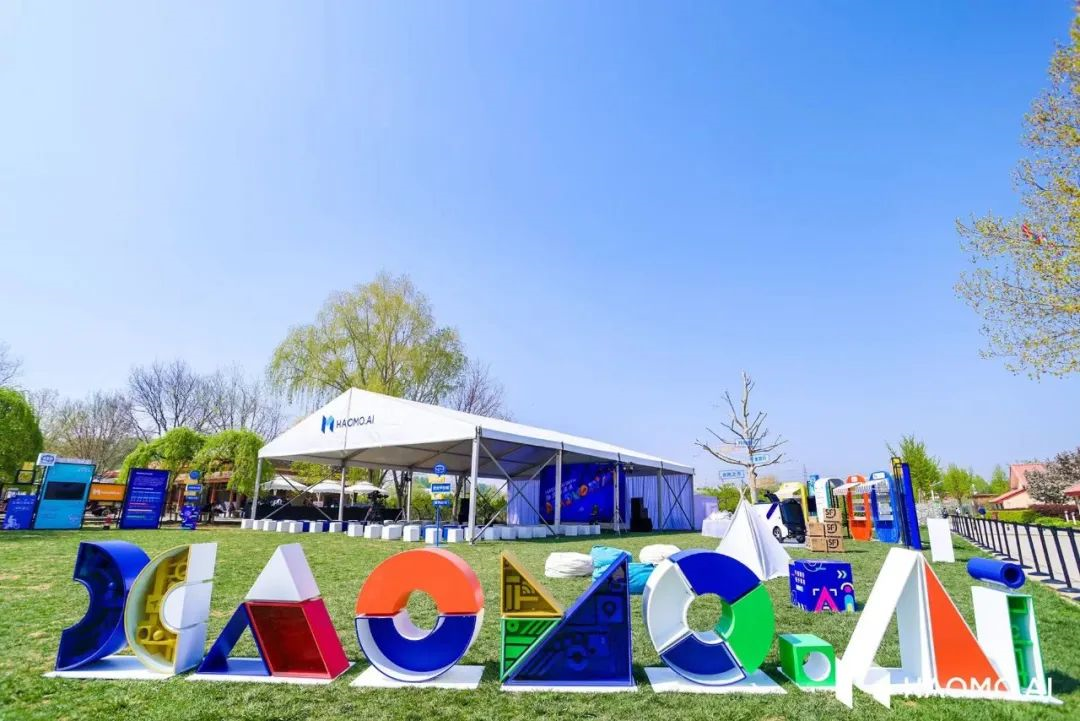Author: Turbocharged Xiao Pangzi
With the entry of major automakers such as Tesla, NIO, XPeng, Ideal, and Great Wall into the field of high-speed navigation assistance, more and more consumers have also experienced the convenience of intelligent driving. Subsequently, as various car companies engage in an arms race in the field of intelligent driving, the arrival of L4+ appears to be picking up pace with the adoption of “1 star, 2 star, 3 star, 4 star”…Lidar technology.
From “assisted driving” to “autonomous driving,” which step should we take first? And how should we proceed? Why don’t we listen to the answer provided by Haomo Zhixing?
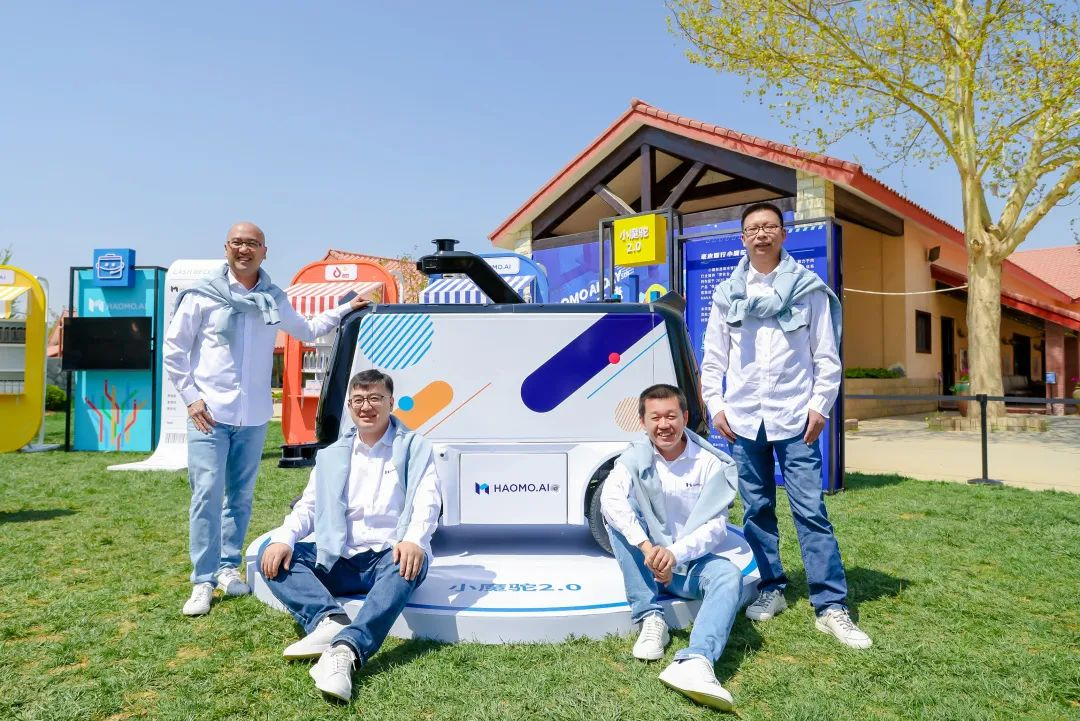
Come on, Show Us
Haomo Zhixing, a self-driving company formed independently by the former “Great Wall Automotive Intelligent Driving Development Department”, is currently working on “passenger car-assisted driving” and “low-speed unmanned vehicle ecosystems.” At the 2022 HAOMO AI DAY, Haomo first showed off some of its achievements:
-
In May 2021, the HWA high-speed assisted driving system went into mass production.
-
In December 2021, the NOH smart navigation assistance driving system went into mass production. The first model to adopt the NOH smart navigation edition was the WEY Mocha. I had previously also experienced the engineering prototype:
-
In December 2021, Haomo released the data intelligence system MANA. Up until now, MANA has completed nearly 200,000 hours of learning, with a virtual driving age equivalent to that of a human driver of 20,000 years.
-
As of the end of 2021, Haomo’s intelligent driving system had been equipped on five models including the WEY Mocha, WEY Latte, WEY Magotan, Haval Shenshou, and Tank 300 urban version. The installation volume exceeded 10,000 units.
-
In March 2022, the sixth vehicle model equipped with Haomo driving system, Tank 500, was officially released.
-
As of April 2022, the user driving mileage of Haomo’s intelligent driving system has exceeded 7 million kilometers.
Haomo City NOH First ReleaseAt the HAOMO AI DAY event, Haomo announced the release of “Haomo City NOH” equipped with HPilot3.0. Haomo City NOH is an intelligent driving system designed to “assist” drivers in city road scenarios based on user-set navigation routes. Currently, Haomo City NOH has completed full functionality development.
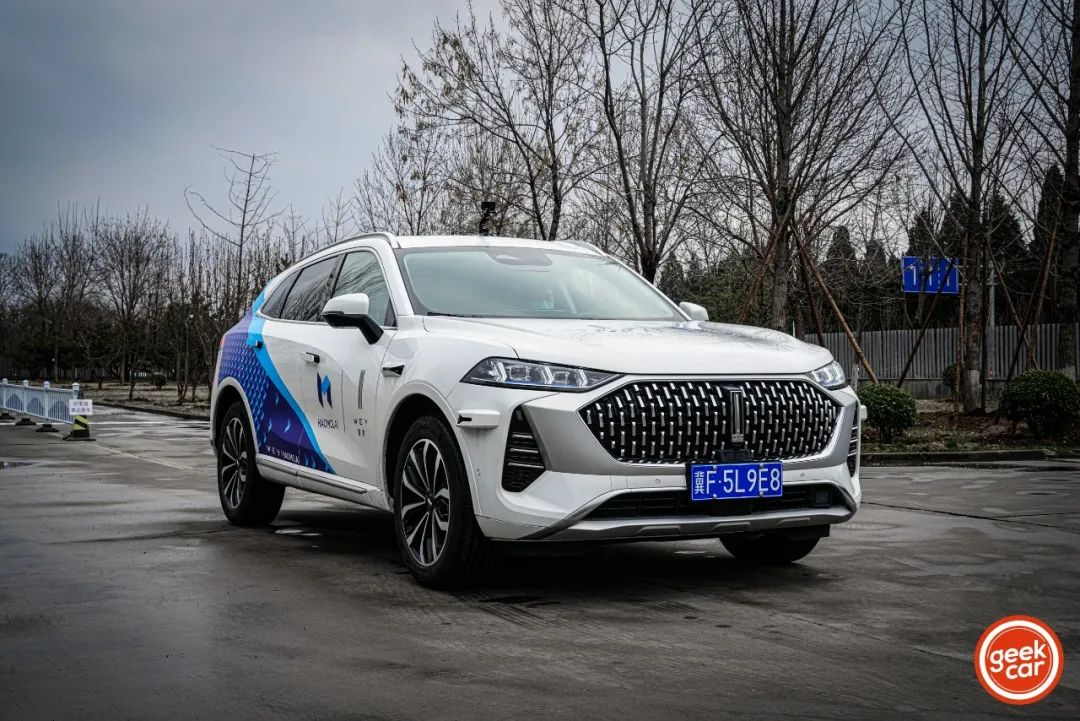
Weipai Moka will become the first model equipped with Haomo City NOH, and the specific landing model information is as follows:
-
Perception hardware: equipped with 2 lidars, 5 millimeter-wave radars, 12 high-definition cameras, and 12 ultrasonic radars;
-
Computing platform: equipped with the “Xiao Mohe 3.0” autonomous driving computing platform jointly launched by Haomo Zhixing and Qualcomm, with 360 TOPS of AI computing power, 144M of high-speed cache, and CPU computing power reaching 200K+ DMIPS;
-
Scenario coverage: Haomo City NOH can automatically change lanes, overtake, recognize and control traffic lights, pass through complex intersections, make unprotected left and right turns and cope with complex urban traffic scenes such as close-range vehicle cut-ins, vehicle blockages, intersections, roundabouts, tunnels, and flyovers in urban environments based on the navigation-provided driving routes.
According to the information provided by Haomo, in Level 4 traffic congestion scenarios (i.e., slow-moving traffic with limited space), Haomo City NOH has a 70% intersection pass rate and a 90% lane change success rate.
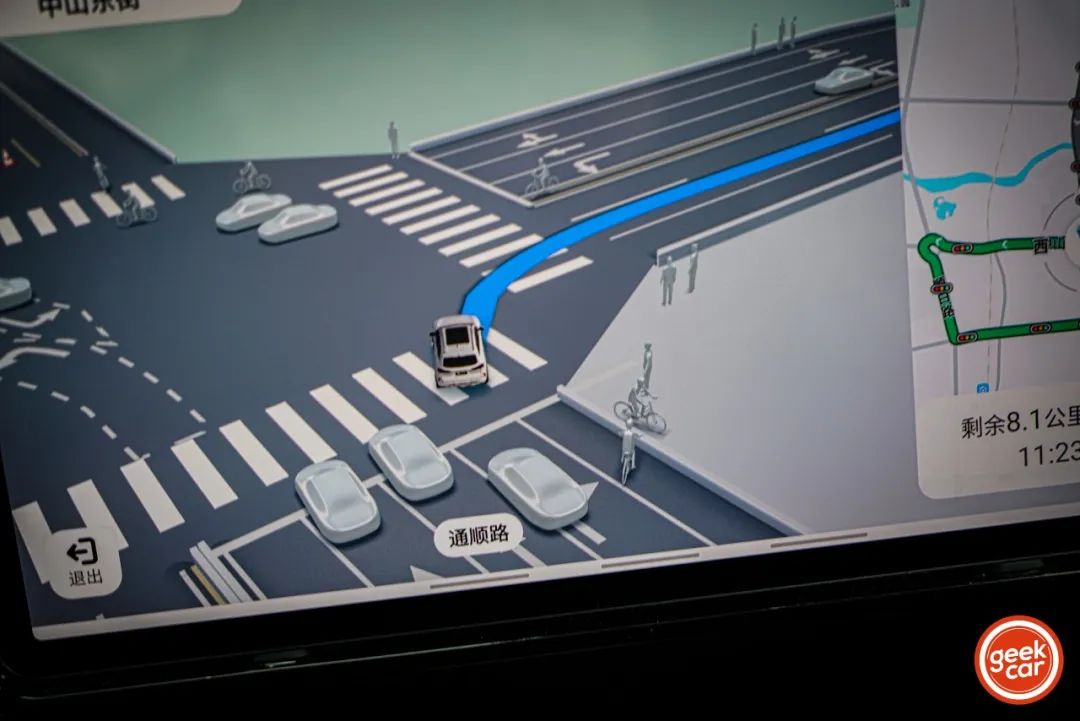
A few days ago, I also experienced the test vehicle of Haomo City NOH (the test vehicle was equipped with 3 lidars):
According to the plan of WM Motor, by 2024, there will be more than 100 cities where “WM City NOH” functions will be implemented, with over 1 million passenger cars equipped with the system, and at the same time achieving integration of high-speed, urban expressways, urban open roads, and parking lots.
MANA Upgrades Again
Since WM Motor released the data intelligence system MANA in December last year, after 4 months, MANA has undergone multiple upgrades in cost reduction and iteration speed improvement.
Perception intelligence: Adopting the “dual-stream” perception model, splitting the red light detection and road binding problems into two channels, WM Motor’s daily passenger car testing achieved red light recognition under heavy perception. The self-developed BEV Transfomer is used for lane recognition, achieving automation of labeling on city roads through “coarse target positioning” and “fine attribute estimation” stages and multi-sensor fusion lane recognition.
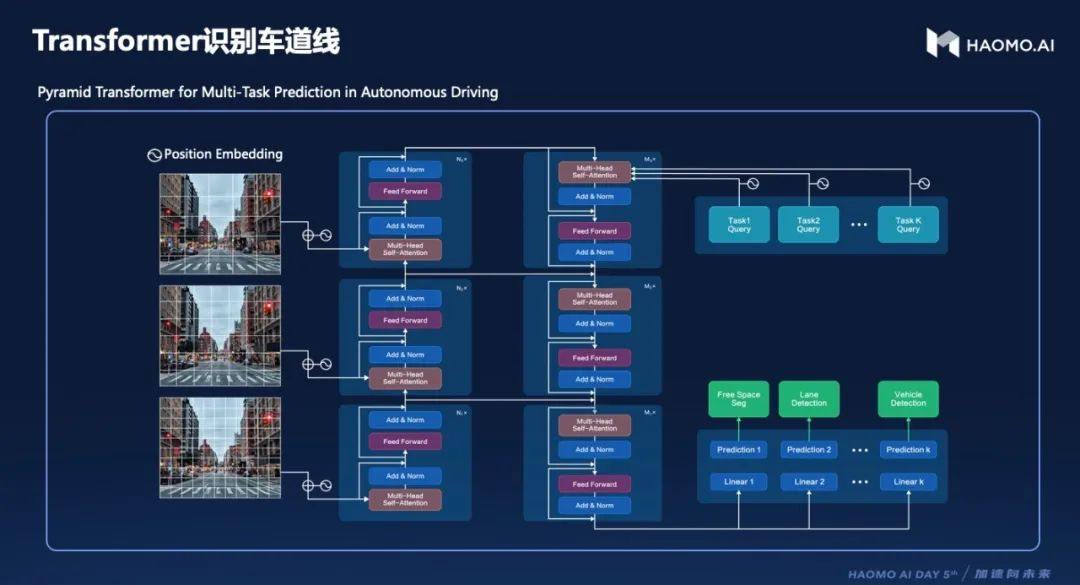

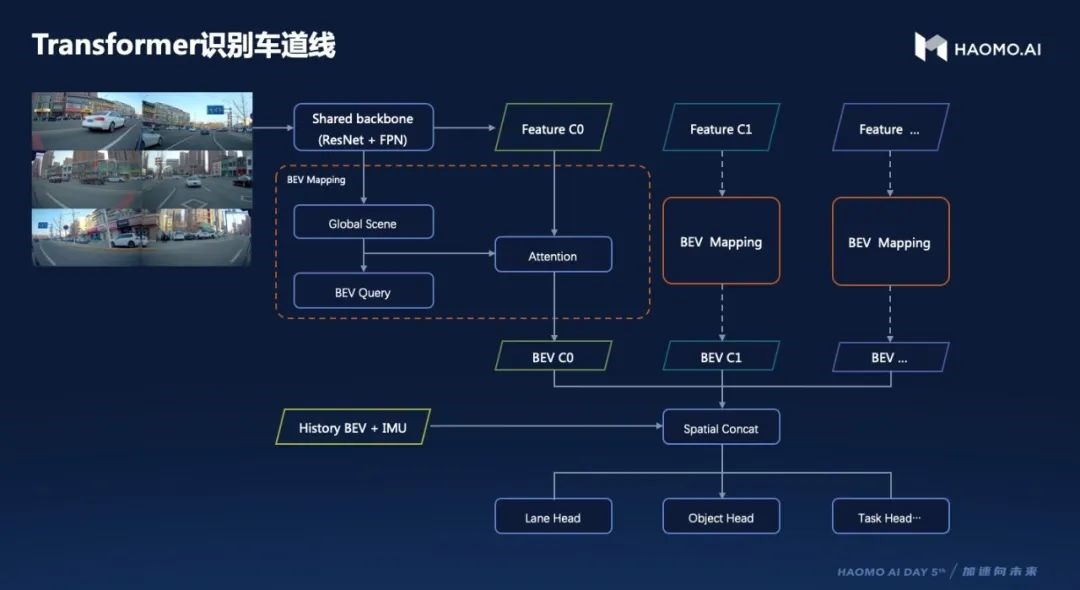
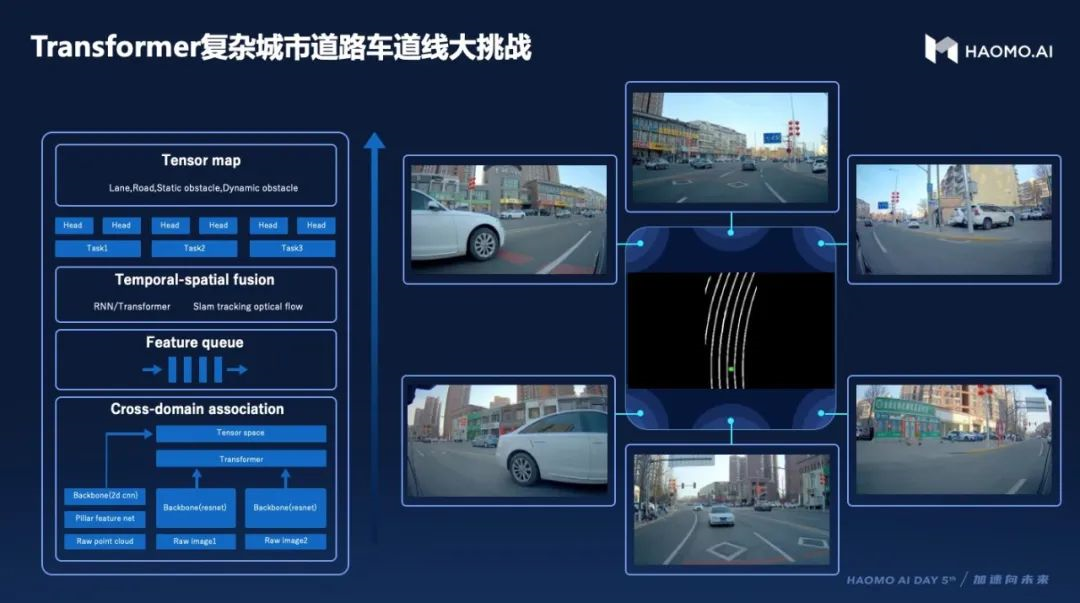
Cognition intelligence: MANA replaced traditional handwritten rules and parameters with machine learning models, solving the problem of bloated code and easy breakdowns of traditional models in complex scenarios, making scene decisions more generalizable with improved interpretability and generalization capability.
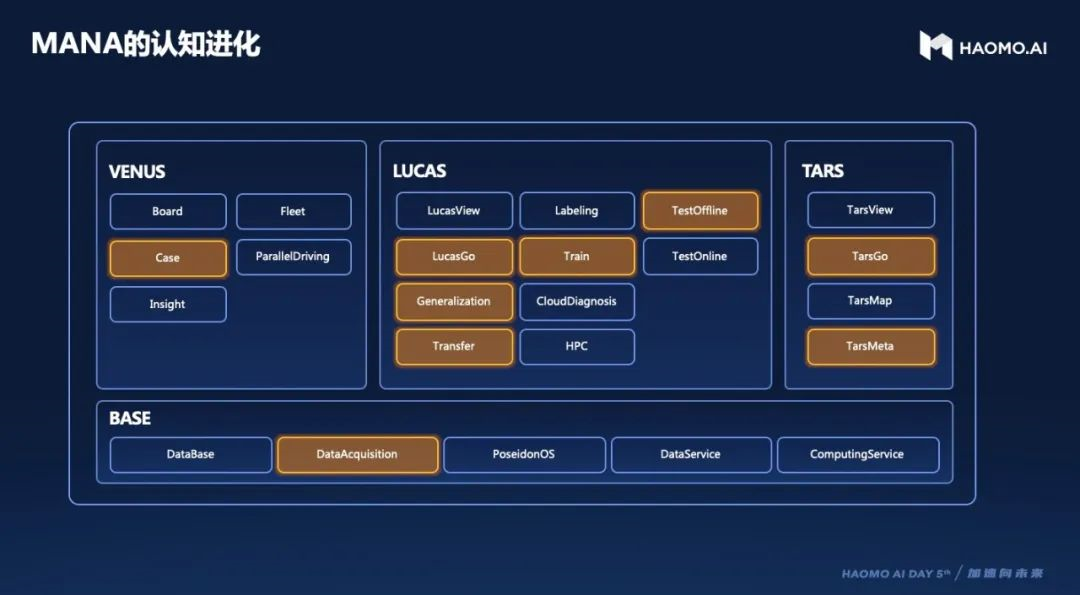
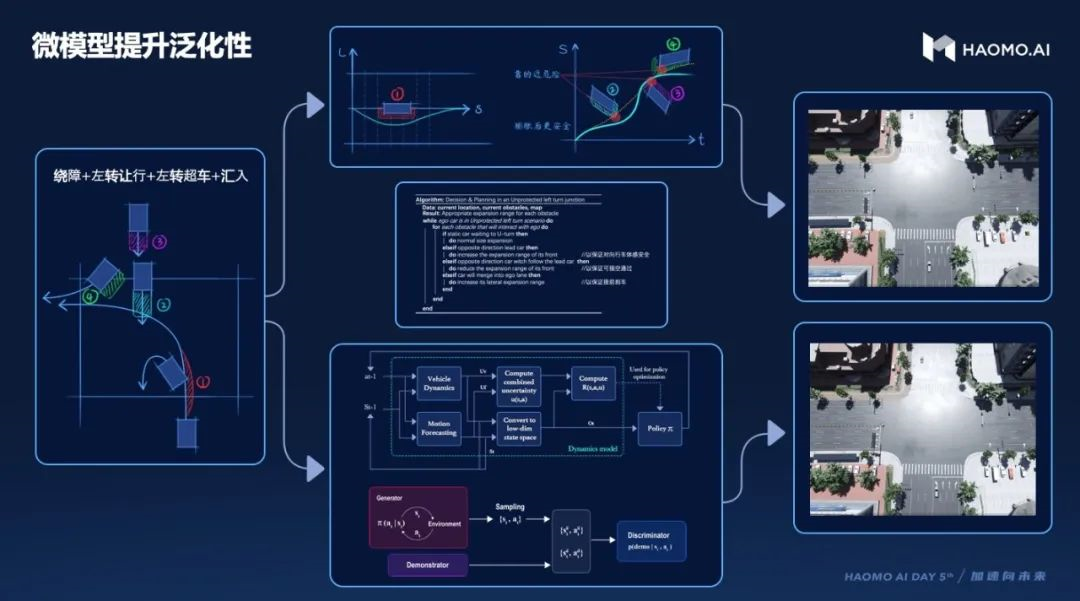 Cost and Speed: The Mo-Mo Mobility Platform team cooperated with the Alibaba Cloud PAI-EFLOPS team to implement distributed training of the Swin Transformer model with a 128-card A100 cluster. Collaborating with Alibaba, the team innovated technologies, including mixed precision optimization, operator optimization, and compilation optimization. Through large-scale model training optimization, the current model training cost has been reduced by 60%, the acceleration ratio has exceeded 96%, and the throughput is over 40,000 samples per second. In addition, Mo-Mo has achieved a labeling AI automation rate of 80%, enhancing labeling efficiency and reducing labeling cost.
Cost and Speed: The Mo-Mo Mobility Platform team cooperated with the Alibaba Cloud PAI-EFLOPS team to implement distributed training of the Swin Transformer model with a 128-card A100 cluster. Collaborating with Alibaba, the team innovated technologies, including mixed precision optimization, operator optimization, and compilation optimization. Through large-scale model training optimization, the current model training cost has been reduced by 60%, the acceleration ratio has exceeded 96%, and the throughput is over 40,000 samples per second. In addition, Mo-Mo has achieved a labeling AI automation rate of 80%, enhancing labeling efficiency and reducing labeling cost.
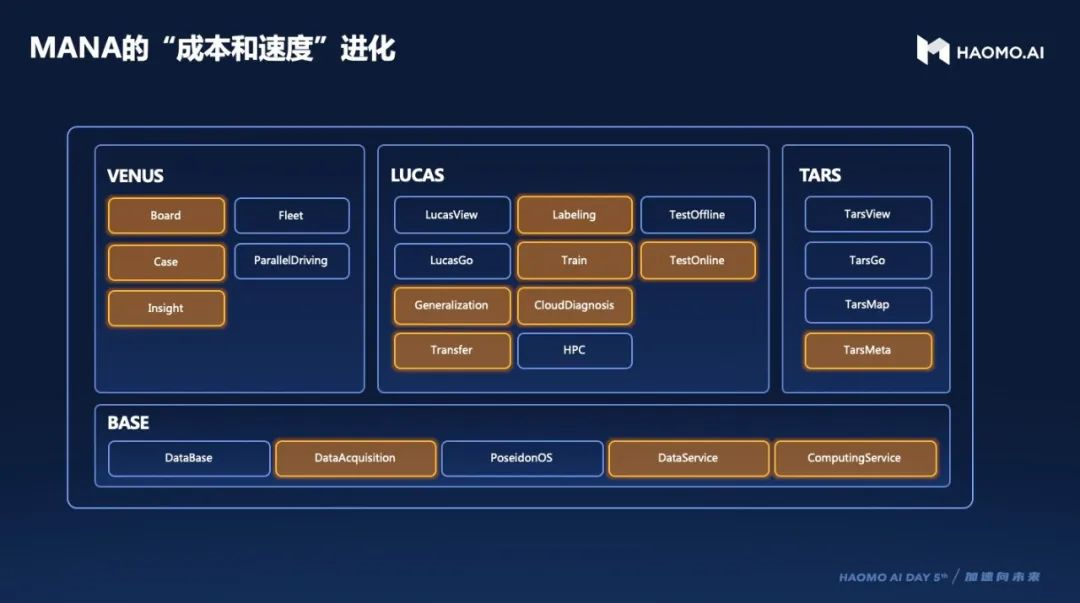
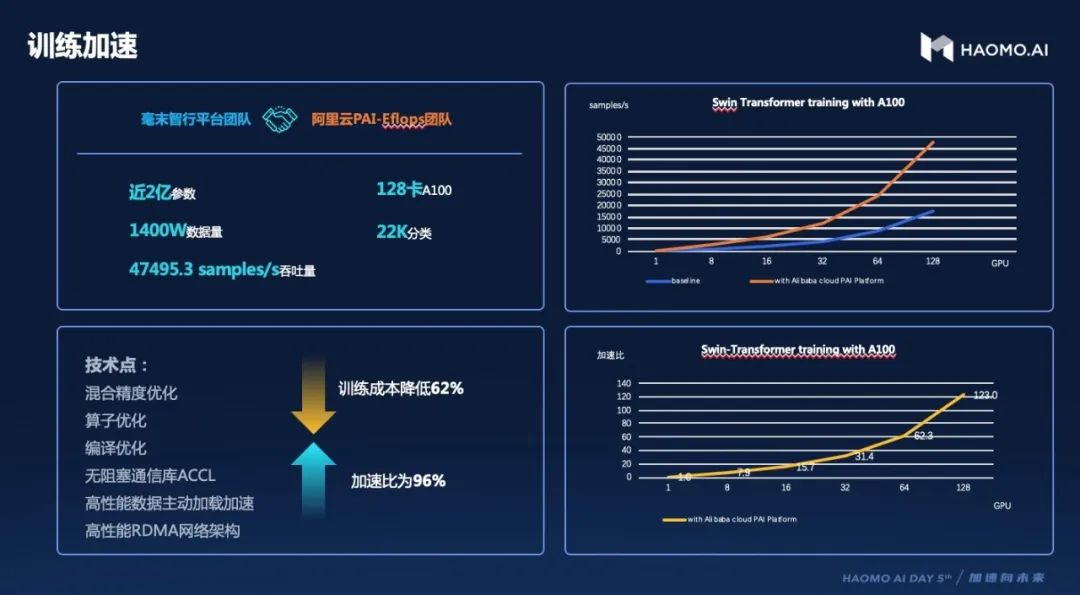
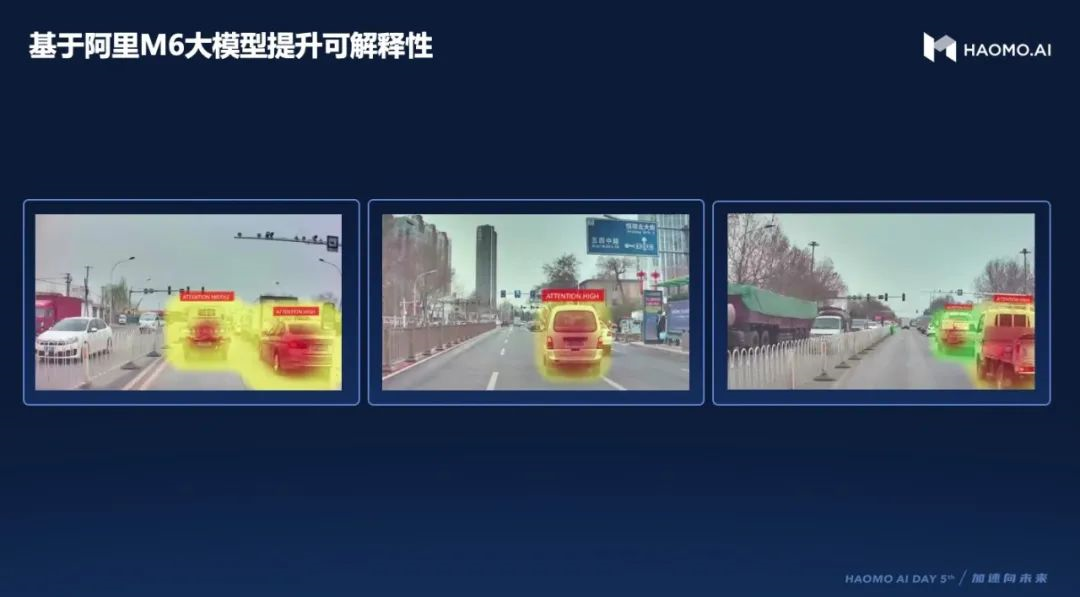
Moreover, Mo-Mo has added privacy protection and data security safeguards to its existing processing network to ensure data security.
Waging a Scale War on Autonomous Vehicles
Mo-Mo unveiled its second-generation autonomous delivery vehicle “Small Camel 2.0” at AI DAY, which is currently the first 100,000-level commercial-end logistics autonomous delivery vehicle in the industry. The vehicle will be successively launched in May 2022.
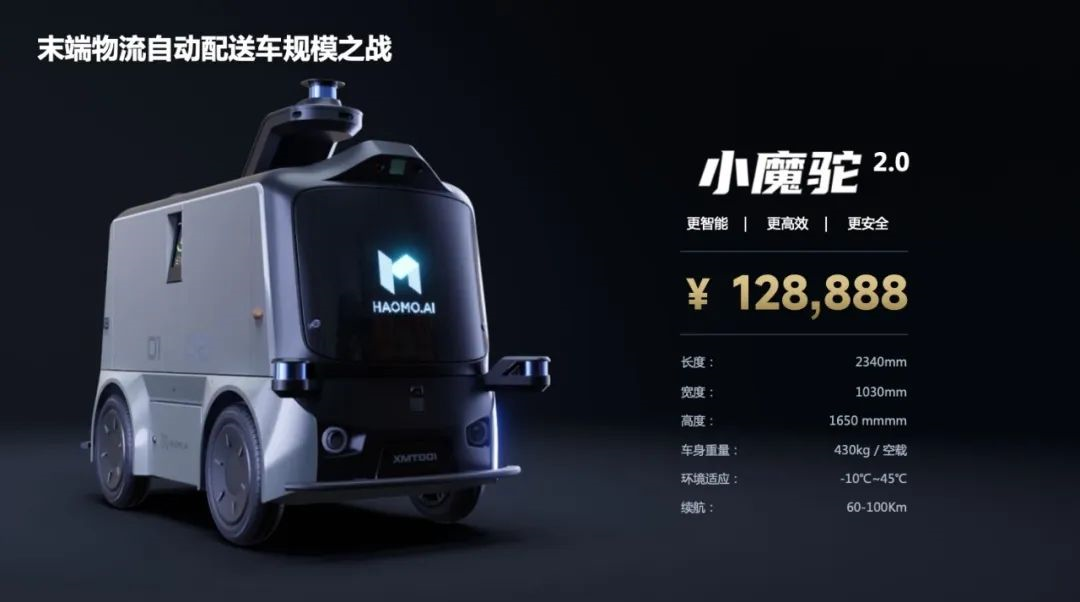
-
Small Camel 2.0 is built on Mo-Mo’s self-developed universal wire-controlled chassis “Small Magic Disk”.
-
Equipped with Small Magic Box 3.0 computing platform, the Small Camel 2.0 has L4 autonomous driving capacity, covering complex traffic scenes such as hybrid traffic and congestion.
-
It is designed with a speed of 40km/h and a working temperature range of -20℃~45℃, supporting all-road conditions of low-speed and high-speed urban open roads in all seasons.
-
The vehicle has a 3.6kwh/6kwh battery pack, providing a range of 60km/100km.
-
Equipped with a 600L cargo box, the vehicle also supports fast battery swapping, intelligent voice interaction, and multi-mode interaction.
Currently, Mo-Mo’s end-of-logistics automatic delivery vehicle factory in Baoding has been fully upgraded, with an area expanded to 10,000 square meters, which can achieve an annual production capacity of 10,000 end-of-logistics automatic delivery vehicles.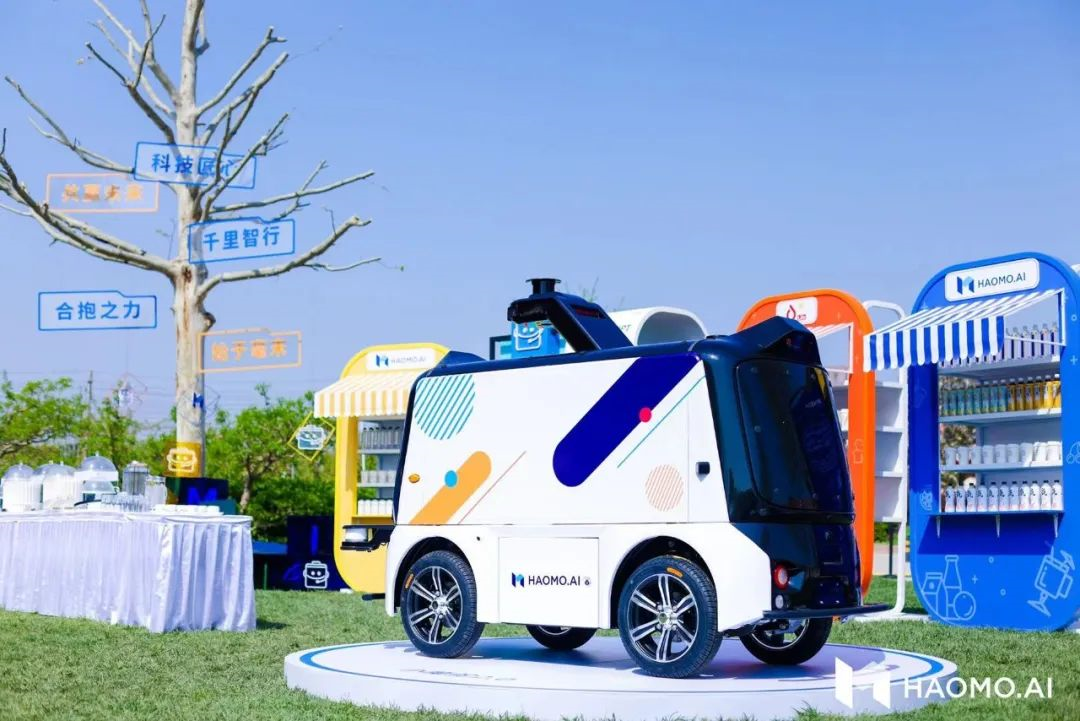
It is obvious that in the field of automated distribution vehicles for end-to-end logistics, Haomo intends to launch a “scale war of unmanned vehicles” with the advantages of “low price, strong performance, full scene, and high productivity”.
Conclusion
In addition to the WEY brand, in the future, Haval and Tank brand models will gradually adopt Haomo’s NOH system. By the end of this year, the Haomo intelligent driving system is expected to be deployed on 34 models. In 2023, Haomo will officially launch the HSD fleet (HAOMO Self-Driving).
This year marks the beginning of the second half of the competition in the field of intelligent driving.
In the field of commercial vehicles, the first half of the game for Robotaxi has already ended, and “scale commercial operation” has become a key word for industry development. In the field of passenger cars, with the increase in penetration rate, the battle for navigation-assisted driving systems has shifted from highways and expressways to urban roads.
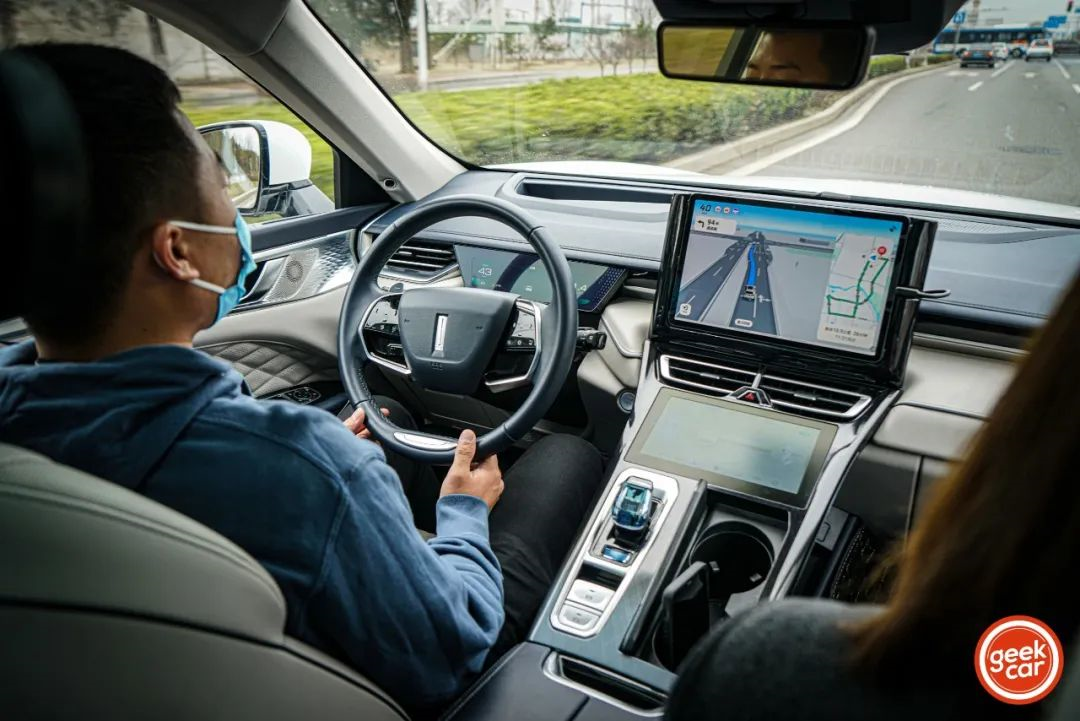
Although as a “latecomer” in the field of intelligent driving, Haomo seems to be catching up at an extremely fast speed. From the software and hardware of the intelligent driving system to the data intelligence system, from passenger cars to unmanned vehicles to the future Robotaxi, the Haomo has completed their layout in the field of intelligent driving.
This article is a translation by ChatGPT of a Chinese report from 42HOW. If you have any questions about it, please email bd@42how.com.
